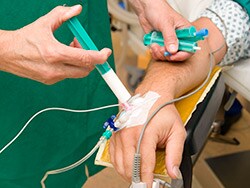During a recent shift, our emergency department (ED) team saw a patient with fairly severe diabetic ketoacidosis. The patient's serum bicarbonate level was 6 mEq/L and the venous pH was 6.85. During discussions with the admitting intensive care team, we debated whether to give intravenous sodium bicarbonate. We chose to withhold it, although the intensive care team initiated a bicarbonate infusion soon after they assumed care. The patient eventually recovered, but it remained uncertain whether the sodium bicarbonate made any difference.

Later during that same shift, a patient arrived in cardiac arrest. It was a 65-year-old man with known coronary artery disease who suffered an unwitnessed arrest with unknown downtime. The initial rhythm when paramedics arrived was asystole, but after three rounds of standard advanced cardiac life support (ACLS) drugs, the patient had pulseless electrical activity with a narrow QRS rhythm at a rate of 60/min. Standard ACLS measures were continued, during which, once again, we debated whether to use sodium bicarbonate for the "prolonged downtime" and suspected acidosis. We gave two doses of sodium bicarbonate, but the patient eventually went into asystole again and was pronounced dead after an hour.
Sodium Bicarbonate Use in the ED
What is the role of sodium bicarbonate in the ED? Its use is well accepted in patients with sodium channel blocker toxicity (eg, tricyclic antidepressant overdose) and patients with aspirin toxicity. I learned to use it in patients with rhabdomyolysis, though its use in these patients is no longer clear, and there seems to be a strong push away from sodium bicarbonate in patients with cardiac arrest, including those with a prolonged downtime. Intuitively, however, its use seems to make sense in patients who are proven or presumed to have a severe metabolic acidosis. It must be good for those patients, right?
In spring 2023, two separate groups evaluated the literature and published rational, evidence-based recommendations for when to use sodium bicarbonate in our ED patients. Their conclusions were similar and are summarized here.
Sodium bicarbonate in patients with metabolic acidosis. The degree of metabolic acidosis, surprisingly, has not been found to independently correlate with mortality, nor has pH improvement been found to improve hemodynamics. Therefore, patients who receive sodium bicarbonate purely for the purpose of correcting acidosis are subjected to the drawbacks of sodium bicarbonate without proven benefits.
What are the drawbacks? Sodium bicarbonate produces hyperosmolarity and can lead to cerebral edema and pulmonary edema. Overuse can produce hypokalemia and hypocalcemia and lead to dysrhythmias and hypotension.
It is also important to remember that bicarbonate is metabolized to carbon dioxide + water, and if the patient has any compromise in the ability to increase minute ventilation (eg, Kussmaul respirations) in order to blow off the carbon dioxide, sodium bicarbonate could actually increase intracellular acidosis. Specifically, for patients with diabetic ketoacidosis, data do not support the use of sodium bicarbonate in patients with a pH > 7.0. Unfortunately, there is a lack of evidence on the utility of sodium bicarbonate in patients with a pH < 7.0; however, neither group of authors endorse the use of sodium bicarbonate for treating metabolic acidosis at any specific pH, and they recommend focusing on identifying and reversing the underlying cause.
Lactic acidosis. Lactic acidosis, defined by a serum lactate > 4 mmol/L and a pH < 7.35, is often associated with sepsis in patients in the ED. Although mortality is increased in patients with lactic acidosis and a pH < 7.1, evidence has shown that the use of sodium bicarbonate has no effect on hemodynamics or mortality in severely acidotic patients except in those with concomitant acute kidney injury (AKI). In the group of patients with lactic acidosis plus AKI, nephrologists and intensivists often start bicarbonate infusions for a pH < 7.1 with a goal of at least a pH > 7.2.
Non–anion gap metabolic acidosis (NAGMA). NAGMA is usually the result of bicarbonate loss in stool or urine. Therefore, sodium bicarbonate is often used to treat patients with NAGMA, along with correcting the underlying cause. Data on improved outcomes in these patients receiving sodium bicarbonate are limited. Nevertheless, both groups of authors endorse the use of sodium bicarbonate in patients with NAGMA. Myers and colleagues specifically state that they "consider a sodium bicarbonate infusion in those patients with a NAGMA, pH < 7.2, and an etiology that is not immediately correctable."
Rhabdomyolysis. In past years, sodium bicarbonate was recommended for patients with rhabdomyolysis in order to alkalinize the urine and prevent precipitation of myoglobin in the renal tubules. Precipitation had been found to occur primarily in acidic urine in animal models. Subsequent studies in humans, however, have found no benefit to the addition of sodium bicarbonate to intravenous fluids for the purpose of urinary alkalinization. The key to treatment for these patients is to maintain good urinary output via unenhanced intravenous fluids.
Hyperkalemia. The authors did not delve deeply into this topic. There is only low-quality evidence suggesting that sodium bicarbonate is effective for lowering serum potassium levels, and there are much more effective therapies available. However, American Heart Association (AHA) guidelines have endorsed its use in presumed or confirmed hyperkalemic arrest.
I have found sodium bicarbonate useful in the setting of wide QRS complex tachycardias (eg, QRS > 200 ms) in order to identify when the tachycardia is caused by hyperkalemia and sodium channel blockers. In both conditions, the QRS complex will transiently narrow within minutes, whereas with true ventricular or supraventricular tachycardias, the QRS remains unchanged. Definitive management can then be tailored to the cause.
Cardiac arrest. Sodium bicarbonate has a longstanding history in managing patients in cardiac arrest. When I was in training in the early 1990s, we often used this medication with the presumption that patients with prolonged arrest times were severely acidotic as a result of hypoperfusion and lactic acidosis; and that the metabolic acidosis was compounded by hypoventilation, buildup of carbon dioxide, and respiratory acidosis. We all presumed that the acidotic state compromised cardiac function, and by reversing the acidosis with intravenous sodium bicarbonate boluses, we would improve the chance of return of spontaneous circulation.
As previously stated, however, we know that sodium bicarbonate is unlikely to improve the hemodynamics of patients with lactic acidosis. Also, the administration of sodium bicarbonate can worsen acidosis in patients who are hypoventilating and unable to expel the carbon dioxide byproduct of bicarbonate. It is no surprise that studies have failed to demonstrate any benefit from routine administration of sodium bicarbonate during cardiac arrest. Current AHA guidelines do not recommend the routine use of sodium bicarbonate, regardless of the duration of downtime, in the absence of either presumed hyperkalemia or sodium channel toxicity.
Viewpoint
When is sodium bicarbonate indicated? The evidence suggests that there are only a few ED indications to administer sodium bicarbonate:
Treatment of sodium channel toxicity and aspirin toxicity, although these were not specifically addressed here
Treatment of patients with severe lactic acidosis who also have a concurrent AKI
Treatment of patients with severe NAGMA
In some circumstances associated with hyperkalemia
The use of sodium bicarbonate in patients suffering from severe metabolic acidosis and lactic acidosis seems to make sense; it can't possibly be healthy to have a very low pH, and it would seem that administering this medication will improve the numbers.
Similarly, the use of sodium bicarbonate in rhabdomyolysis and in patients with prolonged cardiac arrest intuitively seems to make sense and is a longstanding tradition.
But traditions die hard in medicine, and such is the case here. The best evidence does not show a benefit to sodium bicarbonate use in patients with acidosis, rhabdomyolysis, or cardiac arrest, even though it may improve serum and urinary pH. In fact, routine use of sodium bicarbonate may actually harm patients.
The key point we should learn from these articles is that we need to start following evidence and correct the underlying conditions rather than just trying to fix numbers.
Amal Mattu, MD, is a professor, vice chair of education, and co-director of the emergency cardiology fellowship in the Department of Emergency Medicine at the University of Maryland School of Medicine in Baltimore.
Follow Medscape on Facebook, X (formerly known as Twitter), Instagram, and YouTube
Credits:
Images: E+ / Getty Images
Medscape Emergency Medicine © 2023 WebMD, LLC
Any views expressed above are the author's own and do not necessarily reflect the views of WebMD or Medscape.
Cite this: Reevaluating Sodium Bicarbonate Use in the Emergency Department - Medscape - Dec 20, 2023.










Comments